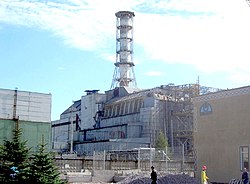Chernobyl Nuclear Power Plant sarcophagus: Difference between revisions
Cybercobra (talk | contribs) →References: formatting |
|||
| Line 41: | Line 41: | ||
== External links == |
== External links == |
||
*{{PDFlink|[http://www.ebrd.com/downloads/research/factsheets/chernobyl25.pdf Chernobyl 25 years on: New Safe Confinement and Spent Fuel Storage Facility]}}. European Bank for Reconstruction & Development |
*{{PDFlink|[http://www.ebrd.com/downloads/research/factsheets/chernobyl25.pdf Chernobyl 25 years on: New Safe Confinement and Spent Fuel Storage Facility]}}. European Bank for Reconstruction & Development |
||
* [http://www.spotimage.com/FlipBook/Tchernobyl/ENG/index.html 25 years of satellite imagery over Chernobyl] |
|||
{{coord missing|Ukraine}} |
{{coord missing|Ukraine}} |
||
Revision as of 12:53, 14 April 2011
| Chernobyl Nuclear Power Plant sarcophagus | |
|---|---|
Ukrainian: Чорнобильський саркофаг | |
 The sarcophagus in 2006 | |
 | |
| General information | |
| Type | Confinement shelter |
| Location | Near Prypiat |
| Country | |
| Construction started | June 1986 |
| Completed | November 1986 |
The Chernobyl Nuclear Power Plant sarcophagus or stone coffin is a massive concrete envelope surrounding the nuclear reactor unit 4 of the Chernobyl Nuclear Power Plant. It is designed to halt the release of radiation into the atmosphere following the Chernobyl disaster on April 26, 1986 and encase the most dangerous area.[1][2] The official Russian name is No 4. ukrytiye which means housing or covering as opposed to sarcophagus.[2] The sarcophagus locked in 200 tons of radioactive corium, 30 tons of highly contaminated dust and 16 tons of uranium and plutonium.[1] In 1996 it was deemed impossible to repair the inside of the sarcophagus as radiation levels were estimated to be as high as 10,000 röntgens per hour (normal background radiation in cities is usually around 20-50 microröntgens per hour).[3]
Construction
The designing of the sarcophagus started on May, 20, 1986. Subsequent construction lasted for 206 days, from June to late November of the same year.[2] The first task before construction started was to build a cooling slab under the reactor to prevent the hot nuclear fuel from burning a hole in the base. Coal miners were called up to dig the necessary tunnel below the reactor and by June 24, 1986 four hundred coal miners had built the 168 metre (551 ft) long tunnel.[4] When the building became overly radioactive it became impossible to directly screw down the nuts and bolts or apply any direct welding to the sarcophagus, so this work was done by robots.[1] The seams of the sarcophagus, however, were not properly sealed. The entire construction process consisted of eight stages: clearing and concreting of territory around reactor unit 4, erection of initial ferro-concrete protective walls around the perimeter, construction of separation walls between units 3 and 4, cascade wall construction, covering of the turbine hall, mounting of a high-rise buttress wall, erection of supports and installation of a reactor compartment covering and finally the installation of a ventilation system.
More than 400,000 m3 of concrete and 7,300 tonnes of metal framework were used during the erection of the sarcophagus.[2] The building ultimately enclosed 740,000 m3 of heavily contaminated debris inside,[1] together with contaminated soil.[4] On October 11, 1986 the Soviet Governmental Commission accepted "Conclusion on Reliability and Durability of a Covering Constructions and Radiation Safety of Chernobyl NPP Unit 4 Reactor Compartment".[5] The sarcophagus has over 60 bore holes to allow observation of the interior of the core.[6] In many places the structure was designed to have ventilation shafts to allow some convection inside.[6] Filtration systems have been put in place so that no radioactive material will escape through these holes.[6]
Replacement

On December 22, 1988 Soviet scientists announced that the sarcophagus would only last 20—30 years before it needed repairing. In 1998, with the help of the European Bank for Reconstruction and Development, a conservation programme was completed which included securing the roof beams from collapsing. Nonetheless the rain-induced corrosion of supporting beams still threatens the sarcophagus's integrity.[4] It was revealed that the water is leaking through the sarcophagus via holes in its roof, becoming radioactively contaminated, and then seeping through the reactor's floor into the soil.[4] In 2013 the New Safe Confinement is expected to replace the existing sarcophagus. The new containment device will allow the sarcophagus to be dismantled and radioactive material to be removed.[7]
Notes
- ^ a b c d "Chernobyl Sarcophagus". Chernobyl International. Retrieved 2010-11-30.
- ^ a b c d Ebel 1994, p. 1
- ^ Marples 1996, p. 30
- ^ a b c d "What happened in Chernobyl?". Greenpeace. Retrieved 2010-11-30.
- ^ "Объект "Укрытие": Сооружение". Chernobyl.by. Retrieved 2010-12-02. Template:Ru icon
- ^ a b c Marples & Risovanny 1996, p. 17
- ^ Wood 2007, p. 63
References
- Ebel, Robert E.;Center for Strategic and International Studies (Washington, D.C.) (1994). Chernobyl and its aftermath: a chronology of events (1994 ed.). CSIS. ISBN 9780892063024.
{{cite book}}: Invalid|ref=harv(help)CS1 maint: multiple names: authors list (link) - Total pages: 43 - Marples, David R.; Risovanny, Yuri (1996). "Revelations of a Chernobyl Insider". Bulletin of the Atomic Scientists . vol. 52 (no. 3): 64. ISSN 0096-3402.
{{cite journal}}:|access-date=requires|url=(help);|issue=has extra text (help);|volume=has extra text (help); Cite has empty unknown parameters:|trans_title=and|coauthors=(help); Invalid|ref=harv(help); Unknown parameter|month=ignored (help) - Marples, David R. (1996). "The Decade of Despair". Bulletin of the Atomic Scientists . vol. 52 (no. 3): 64. ISSN 0096-3402.
{{cite journal}}:|access-date=requires|url=(help);|issue=has extra text (help);|volume=has extra text (help); Cite has empty unknown parameters:|trans_title=and|coauthors=(help); Invalid|ref=harv(help); Unknown parameter|month=ignored (help) - Wood, Janet ;Institution of Engineering and Technology (2007). Nuclear power: Volume 52 of Power engineer (2007 ed.). IET. ISBN 9780863416682.
{{cite book}}: Invalid|ref=harv(help)CS1 maint: multiple names: authors list (link) - Total pages: 239
External links
- Template:PDFlink. European Bank for Reconstruction & Development
- 25 years of satellite imagery over Chernobyl
